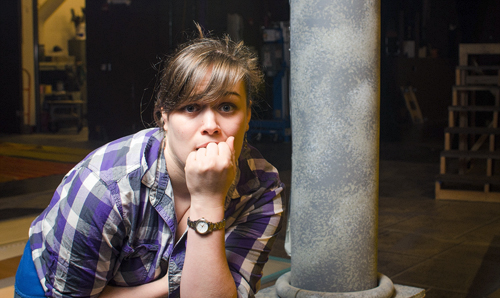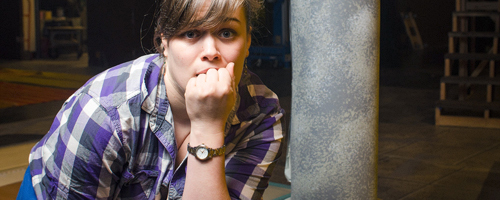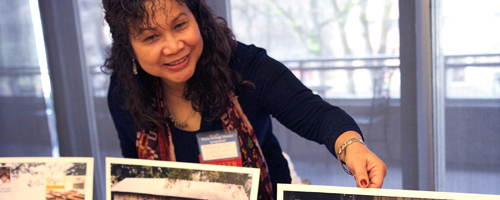How many Portlanders can claim to be the son or daughter of a professional storyteller? Katelyn Lewis, for one. Lewis will also be playing the lead role in one of Carlo Goldoni’s earliest and most well-known comedies, The Servant of Two Masters, which opens this Thursday with a low-cost preview on campus.
It’s Truffladina, not Truffladino!

How many Portlanders can claim to be the son or daughter of a professional storyteller? Katelyn Lewis, for one.
Lewis will also be playing the lead role in one of Carlo Goldoni’s earliest and most well-known comedies, The Servant of Two Masters, which opens this Thursday with a low-cost preview on campus.
In addition to being a professional storyteller, her father, Mark Lewis, has won two Emmys. The rest of her family have also been involved in theater and film for quite some time.
Lewis, a theater major at Portland State, has “theater in her blood,” she said.
She brings this passion and tradition with her to the stage in PSU’s production of The Servant of Two Masters, a modern expression of Italy’s classic comedic style, the Commedia dell’Arte.
Two Masters is a farcical comedy, written during the first half of the 17th century. Commedia dell’Arte is a style of theater that began in the 16th century.
Lewis described the genre as “bigger than life” and “full of ridiculous situations.” The audience will see to characters “fighting, falling, catching and falling in love.”
At one point in the story, Truffladina—whom Goldoni originally wrote as Truffladino, a male—questions the audience about what took place while she was backstage (snacking on something, no doubt).
“Food is what drives Truffladina throughout the whole story—she talks about food the whole time,” said Kristi Bogart, a theater arts graduate student who has been acting professionally since 2005 and plays the role of Brighella.
PSU’s production uses a script adapted from the original for 2009’s Oregon Shakespeare Festival.
“It was…reinvented with a modern element,” Lewis said.
“That was part of the fun about this particular production: trying to relate it to Portland and Portland State,” said Daniel Meeker, PSU faculty member and scenic and lighting director for the production.
The cast of The Servant of Two Masters has had the opportunity to work with guest director Jessica Wallenfels, who has “brought a fresh look” to the comedy, according to Lewis.
“[Wallenfels] has a background in the Commedia dell’Arte [tradition] in addition to the art of clowning, which is a style of theater,” Meeker said.
Wallenfels has brought her expertise and creativity to this production, electing to perform a gender-blind production, which is why Lewis was chosen to play the role of Truffladino and why the servant now answers to Truffladina.
The spirit of Commedia dell’Arte, coupled with Wallenfels’ direction, will give the show a distinctly Portland feel: Characters reference streets like Market and Main and discuss issues such as budget cuts and Portland spots like PSU’s own The Cheerful Tortoise.
This personalization of a script is classic Commedia dell’Arte.
The Servant of Two Masters
Low-cost preview: Thursday, Feb. 28, 7:30 p.m.
Friday, March 1, to Sunday, March 3, and Wednesday, March 6, to Saturday, March 9
All shows at 7:30 p.m., except Sunday at 2 p.m.
Lincoln Performance Hall
Preview tickets $6, main performance $12 (general admission), $8 (PSU students and staff)
“[Classic performers] would set themselves up and get acquainted with the town, the street names, the issues of the city, political intrigue and other such matters,” Bogart said.
Next, they would tailor their dialogue to reference these landmarks and issues at hand. Acting in this style would allow the actors to improvise.
“Traditionally, there was no script,” Bogart said. “There were basic plot points to meet in the scene, but how they got there” was up to the players. Stories were retold myriad ways.
“People are still in disagreement as to whether theater and acting is an art or a craft,” Lewis said, and the Commedia dell’Arte is an illustration of this disagreement.
Commedia dell’Arte has its roots in the latter half of the 15th century and blossomed in the 16th. It was a big step in theater, Lewis said.
The style of Commedia dell’Arte is “bigger-than-life slapstick reminiscent of The Three Stooges,” she added. Two Masters is an “over-the-top, physical, farcical comedy.”
Traditionally, Commedia dell’Arte uses the mask as a key prop. However, the strength and physicality that the actors employ in Wallenfels’ version of the play comes from the “idea that the actor must support the mask with his or her whole body,” Wallenfels said.
Although masks are not present in this version, the intense physicality certainly is.
“All characters in this style of theater have four different emotions: happy, sad, scared and [angry],” Bogart said. “They are all extremes, demonstrated through the face and, more importantly, physical posture.” The mask is gone and the body becomes all the more important.
Commedia dell’Arte has a rich and lengthy history, and the cast and crew of Two Masters hope to add to it with this performance, which they have been working at tirelessly.
They’ve been “rehearsing five nights a week, sometimes until midnight, with one of the best groups of people,” Lewis said, and are “continually encouraging each other to hit [our] marks and push each other, physically as well as artistically.”
Lewis thinks that The Servant of Two Masters has something to offer anyone who wants a night of light entertainment.
“Anyone who wants to laugh will enjoy this show,” she said. “It’s funny, sexy and silly.”





